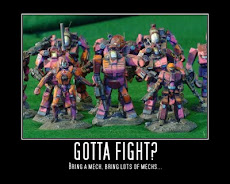Wednesday, 3 October 2012
Scale 2: More About Scale
The trouble with using a ground scale smaller than the figure scale is that models will be bigger than the terrain features. This is especially true of buildings that are in scale with the vehicles, because what appears by linear measurement to be quite large area often ends up as just enough room to fit three small buildings. Hardly the town it is supposed to represent?
Put another way, a village scales up as having multi level hovels!
On the other hand buildings to the same scale as the terrain will be dwarfed by the vehicles, and the problem is made worse in games like BattleTech, because the mechs already dwarf buildings as a matter of course. Then there is the problems of representing roads, rivers and woods when ground scale to figure scale generated distortion. At the end of the day it can all look ludicrous, and undermine the purpose of having the miniatures and terrain in the first place, which is of course to make playing the game easier and things look more realistic.
Let us consider the problems in detail and go back to our hypothetical 6' x 4' wargaming table. At 1/300 ground scale it is the equivalent to an area of 18 x 12 hexes, whereas a similar hex mapboard equivalent in 1/900th scale would be an area of 2' x 1.5'. Therefore a six by four table is similar to using four Battletech map boards at 1/900 ground scale, but only one map board at 1/300.
Now if we took the Atlas, with its auto-cannon 20, and placed it on the table at 1/900 ground scale the range of its weapon is 30 centimeters, but if you were to use 1/300th, then the range would leap up to 90 centimeters. At the larger scale the Atlas would dominate the whole table with its 180 centimeters (six foot) diameter of fire, which would mean that the emphasis of the game had changed. The area to move in is such that all the combat is now taking place at very close range from the start, and this leaves no room for manoeuvre.
This would cast a different light upon the the types of mechs it would be advantageous to field and change the nature of the game.
However, using the 1/900th scale also has its problems. Since the ground scale is so much smaller than the model one, there are going to difficulties when fighting in and around towns, for reasons stated earlier. Also, our table has now become much larger which is not necessarily the advantage it first appears to be.
This is because play testing has shown that there is a relationship between the size of an area to weapon ranges at the sort of model densities which are fielded. Battletech slows down considerably when you get much above a dozen models on the board. The use of 1/900th scale on a six by four table means that the game will literally eat a dozen models, and you'll wonder where they've all gone. Most of the action will take place in the centre with everything milling around each other.
Subscribe to:
Post Comments (Atom)







.png)





Did you ever play OHMU? That tried to use realistic weapon ranges, with the result that (at least for me) the game was about cover to the exclusion of pretty much all else.
ReplyDeleteBattleTech quite explicitly has implausibly short weapon ranges in order to make the game about matching engagement envelopes with your opponents and finding the sweet spot. The 'Mech that's a good city fighter (short-range weapons, jump jets) will often do badly in more open terrain (longer-range weapons), which isn't something you often see with real-world tanks.
As far as terrain goes, when I've played with it at all I've tended to make the vertical figure-scale even if the horizontal isn't - that way one can still use it for sightlines.
oh the irony...
DeleteI wrote OHMU.
:-(
I wondered but wasn't going to say anything. :-) We have actually met before, then, but not for long.
DeleteI remember you from way back when, you are instantly recognisable by your beard and glasses. No seriously, I said I knew you when we met at Congenial.
Delete